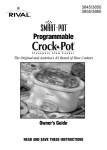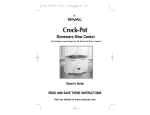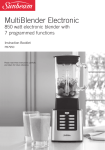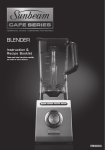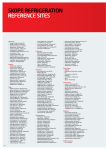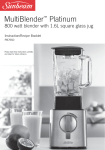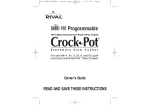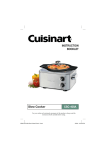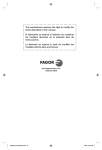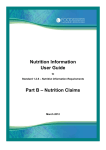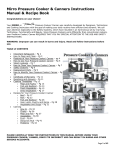Download Food Business - Kilojoule Display User Guide for ACT
Transcript
Kilojoule Display User Guide for Act Food Businesses Nutrition labelling for standard food items Updated June 2015 Contents 1 2 3 4 5 6 Introduction .....................................................................................................2 1.1 Background ...................................................................................................... 2 1.2 About this document ......................................................................................... 2 1.3 Legal requirements and definitions ..................................................................... 2 1.4 More information is available ............................................................................. 2 1.5 Acknowledgements ........................................................................................... 2 Mandatory nutrition labelling requirements .....................................................3 2.1 What information must be displayed? ................................................................. 3 2.2 Who must comply with these requirements? ....................................................... 3 2.3 How can a business determine if the kJ display laws apply to them? ..................... 2 2.4 How must the information be displayed?............................................................. 2 2.5 Can a business voluntarily display this information? ............................................. 3 Interpretation ...................................................................................................3 3.1 Can the average kJ content be displayed per 100g or per serve? .......................... 3 3.2 Does the average kJ content need to be displayed for added food? ....................... 3 3.3 How should the name and price of standard food items be displayed? ................... 3 Frequently asked questions for businesses ......................................................3 4.1 Displaying the average kilojoule content ............................................................. 3 4.2 Displaying the reference statement .................................................................... 5 4.3 Locations for the display of nutrition information ................................................. 6 4.4 Assessing compliance ........................................................................................ 6 4.5 Calculating the average kilojoule content ............................................................ 6 4.6 Requirement for beverages ................................................................................ 7 4.7 Requirements for bakery products ...................................................................... 7 4.8 Requirements for cakes ..................................................................................... 8 4.9 Requirements for hot foods ............................................................................... 8 4.10 Requirements for salads ................................................................................. 8 4.11 Requirements for ice cream ............................................................................ 9 4.12 Requirements for supermarkets ...................................................................... 9 Example menu board, food display cabinet and menu brochure ....................10 5.1 Example: Menu board ..................................................................................... 10 5.2 Example: Food display cabinet ......................................................................... 11 5.3 Example: Menu brochure ................................................................................. 11 Appendices .....................................................................................................12 Kilojoule Display User Guide for ACT Food Businesses Page 1 of 12 1 Introduction 1.1 Background The kilojoule display laws commenced on 1 January 2013 and require certain ACT food businesses to display the kilojoule (kJ) content of their standard food items. Businesses affected by the laws may include supermarkets, convenience stores, and larger fast food/snack chains. The purpose of the laws is to provide consumers with nutritional information that will allow them to make informed food choices. The requirements form part of the Food Act 2001. The Health Protection Service (part of the ACT Government Health Directorate) has regulatory responsibility for the Food Act. Kilojoule display laws have also been introduced in other Australian jurisdictions. Although these laws are all similar, it is important that ACT food business proprietors ensure they comply with the ACT laws. 1.2 About this document This document contains information designed to help businesses covered by the kJ display laws to comply with the new requirements. It also includes answers to questions that have been raised by stakeholders that may not be clear from reading the legislation alone, as well as information about the practicalities of implementing nutritional information. 1.3 Legal requirements and definitions The requirements for point-of-sale kJ displays are outlined in the Food Act 2001. It is available on the ACT Legislation Register (www.legislation.act.gov.au). Presently, the legal requirements are limited to the display of kJs. 1.4 More information is available For more information on the laws, visit www.health.act.gov.au/kjdisplays or call the Health Protection Service on (02) 6205 1700. NSW has developed a consumer information website (www.8700.com.au) that aims to assist consumers to use kJ displays to make informed food choices. The website explains what kJs are, how to work out an individual’s estimated daily kJ requirement and allows consumers to search the kJ content of over 3,000 popular foods from fast/snack food chains. 1.5 Acknowledgements This guide is based on a national template that was developed by the Implementation Sub Committee’s Point-of-Sale Nutrition Information Implementation Working Group. The graphics in this guide were developed by the NSW Food Authority. Kilojoule Display User Guide for ACT Food Businesses Page 2 of 12 2 Mandatory nutrition labelling requirements 2.1 What information must be displayed? Standard food outlets must display the following nutrition information: • the average energy content of each standard food item for sale at the standard food outlet, expressed in kilojoules (kJ), and • the reference statement ‘The average adult daily energy intake is 8,700 kJ’. 2.2 Who must comply with these requirements? Only standard food outlets that sell standard food items are required to comply with the legislation. Businesses that primarily provide food catering services are exempt from the ACT kJ display laws. Standard food outlet means a food business that sells standard food items at other premises or as part of chain/franchise arrangements. Only standard food outlets that sell food from seven or more places in ACT, or 50 or more places in Australia are required to comply with the laws. The types of standard food outlets affected by the laws include: • quick service restaurants • bakery chains • convenience stores • ice cream chains • dine-in chain restaurants • doughnut chains • pizza chains • beverage chains • coffee chains • salad chains Standard food item means an item of ready-to-eat food that is sold in servings that are standardised for portion and content and that is listed on a menu, or displayed with a price tag or label. Standard food items sold as a combination (e.g. a meal deal) are also included. Ready-to-eat food means food that is intended to be eaten without having anything further done to it by the consumer before consumption (e.g. hamburgers, doughnuts, pizza). However, ready-to-eat food does not include nuts in the shell or raw fruit or vegetables that are intended to be hulled, peeled or washed by the consumer (e.g. pistachio nuts, bananas, oranges) so these foods are not required to comply with the legislation. Ready-to-eat packaged foods that arrive at the premises in a wrapper/container in which they are then sold are not standard food items (e.g. chocolate bars, pies in a plastic wrapper, pre-packaged sandwiches). Kilojoules do not need to be displayed for these items unless they are part of a meal deal (refer to section 4.6 for more information). Standardised for portion and content means that the food items are sold in standard serving sizes (e.g. small, medium, large) and prepared from a standard recipe. Kilojoule Display User Guide for ACT Food Businesses Page 3 of 12 2.3 How can a business determine if the kJ display laws apply to them? An ACT food business can determine whether or not the kJ display laws apply to them by answering ‘yes’ or ‘no’ to the questions in the diagram below. Start here Do you sell Standard Food Items? You do not need to display kJs No Yes Is your business in a chain, franchise etc that sells food No from 7+ places in the ACT or 50+ places in Australia? You do not need to display kJs Yes You need to display kJs 2.4 If you display kJs voluntarily, you still need to comply with the laws How must the information be displayed? When displaying the average kJ content for a standard food item it must be: • clearly legible, • expressed as ‘kJ’ (kilojoule is used in the legislation instead of calories because it is the internationally accepted metric unit of measurement for energy), • in the same font, and at least the same font size, as the price, or if no price is displayed, as the name of the item, and • adjacent to, or in close proximity to, the name or price of the item. If standard food items are displayed on the menu and a tag, the average kJ content needs to be displayed on both the menu and the tag. Where the numerals in the price vary in size (e.g. $7.00), the font size used for the kJ content must be at least the same size as the largest numeral in the price. When displaying the reference statement it must be: • clearly legible, • in the same font, and at least the same font size, as the name of the standard food item with the largest font size, or if no name is displayed, as the price of the item, and • adjacent or in close proximity to the item(s), so as to be clearly associated with them. There are some display variations specifically for supermarkets (see section 4.12 for details). Kilojoule Display User Guide for ACT Food Businesses Page 2 of 12 2.5 Can a business voluntarily display this information? Yes. Standard food outlets that are not required to comply with the legislation can voluntarily display the nutrition information. In doing so, the information must be displayed in accordance with the requirements outlined above. Penalties apply for standard food outlets that voluntarily display this information without complying with these requirements. 3 Interpretation 3.1 Can the average kJ content be displayed per 100g or per serve? Unless your business is a supermarket, the average kJ content must be displayed for the whole standard food item and not per 100g or per serve (see section 4.12 information on kJ displays in supermarkets). This requirement applies to standard food items intended as single (e.g. doughnut, hamburger, muffin) or multiple serves provided they are sold as one item (e.g. pizza, tea bun, cheesecake). The regulation does not prevent businesses from additionally displaying the average kJ content per 100g or per serve where a standard food item is sold as multiple serves. This is a marketing and design question for the business affected. Displaying the number of suggested serves, and the corresponding average kJ content per serve, is preferable to showing kJ per 100g, as it provides more useful information for consumers. For example: Tea bun 8610 kJ (suggest 7 serves/1230 kJ per serve) 3.2 Does the average kJ content need to be displayed for added food? If food is added to a standard food item for an additional price, and this is displayed on a menu board, then its average kJ content must be displayed. For instance, a menu stating ‘side of chips - $3’ would need to display the kJ content of the added serve of chips. If the added food is not a standard food item, then its average kJ content does not need to be displayed. For instance, a menu may list a variety of toppings that may be added to an ice-cream. If these toppings are not added in a standardised way (i.e. the customer always dictates the amount and variety of toppings that are added), they are not a standard food item. 3.3 How should the name and price of standard food items be displayed? There are no rules about the display of the name or price of standard food items. The laws only apply to the display of the average kJ content of standard food items (refer to section 2.4 for more information). 4 Frequently asked questions for businesses 4.1 Displaying the average kilojoule content Does the average kJ content need to be displayed for a food category? The legislation requires that the average kJ content of standard food items be displayed. The legislation does not require the average kJ content to be displayed where products are displayed as a food category. A ‘category’ implies that there are multiple items which fall within the description. As such, a category cannot be considered a standard food item. Example 1 – the average kJ content would not need to be displayed on an in-store poster advertising a ‘Muffin & Coffee $5.50’, where the customer can choose any muffin and any coffee, as both are food Kilojoule Display User Guide for ACT Food Businesses Page 3 of 12 categories. However, the average kJ content would need to be displayed for a ‘Blueberry Muffin & Regular Cappuccino’ combo deal as they are standard food items. Example 2 – the average kJ content would not need to be displayed on the menu for ‘Milkshakes $2.50’ as this is a food category. However, the average kJ content would need to be displayed on the menu for ‘Strawberry Milkshake $2.50’, which is a standard food item. Example 3 – the average kJ content would not need to be displayed on a tag descriptor ‘Filled Donuts’, where the customer can choose from a variety of different donuts (e.g. jam, cream, custard) as this is a category and each donut would have a different kJ content. However, the average kJ content would need to be displayed for a tag descriptor ‘Jam Donut’ as this is a standard food item. How is the average kJ content displayed when one price is listed for multiple items? Where a number of standard food items are listed on a menu with the same price (listed only once) the average kJ content for each item can be displayed: • in the same font and at least the same font size as the price of the items, or • in the same font, and at least the same font size as the name of the standard food items. Example 1 – a pizza menu has ten pizzas displayed on a menu for sale as $10.95. The price is listed only once on the menu in large font. As this price is for more than one pizza, a business can display the average kilojoule content in the same font and at least the same font size as the name of each individual pizza. Example 2 – a sandwich menu has five sandwich varieties listed on a menu, all for sale as $9.95. The price is listed only once on the menu in large font. As this price is for more than one sandwich, a business can display the average kilojoule content in the same font and at least the same font size as the name of each individual sandwich. Can nutrition information be displayed on a wall poster instead of on a menu? No, the legislation does not allow for wall posters to replace menus in meeting the requirements. Individual businesses may choose to provide other forms of additional or supporting information. However, the obligation to display nutrition information in accordance with the legislation remains. How is the average kJ content displayed when a standard food item can be personalised by the customer? (e.g. latté with full, skim, soy milk, etc) In this situation the average kJ content that needs to be displayed is the ‘default’ standard food item. Using the example above (i.e. latté), a business would not need to display the average kJ content for all the possible milk options (as these are not the ‘standard food item’ on the menu). They would only need to display the average kJ content of the ‘default’ milk that would be sold with the latté if the customer did not personalise their order (i.e. the customer orders the standard food item from the menu with no variation). If there are multiple flavours for a standard food item on a menu, does the average kJ content need to be displayed for each flavour? If multiple flavours are displayed on a menu (e.g. chocolate, strawberry, caramel) for a standard food item (e.g. milkshake or thickshake), the kilojoules of each flavour must be displayed and meet the display requirements (refer to section 2.4 for more information). Kilojoule Display User Guide for ACT Food Businesses Page 4 of 12 How must average kJ content be displayed for meal deals? A ‘standard food item’ can be a combination of items (e.g. a meal deal consisting of a burger, chips and a drink). The average kJ content for the meal deal must be displayed. The legislation also requires that meal deals sold in different sizes (e.g. small, medium, large) must be treated as separate standard food items. This means that if meal deals are sold in different sizes the total number of average kilojoules for each size must be displayed. Where meal deals are not a standard food item (in that there is no default and a significant degree of customisation by the consumer), they are not required to be labelled as a whole. However, each of the individual line products and sizes are to be labelled with the average kJ content of the food item to enable consumers to determine the total content of their order once they have customised it. Are there any thumbnail, colour guide or print size requirements? There are no thumbnail (i.e. front-of-pack display information) or colour guide requirements for the display of nutrition information. Section 2.4 provides guidance on the print size for the display of kJ information. Are items sold for catering purposes required to comply? Food businesses that primarily provide food for catering purposes (i.e. made to order) are exempt from the nutrition labelling requirements. 4.2 Displaying the reference statement Where must the statement ‘The average adult daily energy intake is 8700 kJ’ be placed? The statement must be placed: • in one location on each menu (including posters, menu boards, drive-through menu boards) adjacent to, or in close proximity to, the standard food item or items so as to be clearly associated with them, and • in each area or display cabinet, or on each stand, where standard food items with tags or labels are displayed and adjacent to, or close proximity to, the item or items so as to be clearly associated with them by customers. The precise location or display of this statement is a matter for each business to determine. For display cabinets, one possible way of complying with the legislation would be to place the statement on a banner (or ribbon) that runs across the front of the cabinet. How many times must the reference statement be displayed? The ACT is taking a practical approach to this requirement and if, for example, two menu boards were next to each other, one statement for the two boards would be considered acceptable. For printed menus, one statement every second page would be considered acceptable. The reference statement does not need to be included on every page. A business’ interpretation of the meaning of a ‘menu’ determines how often the statement must be displayed: • if a business interprets that each panel is a menu, the reference statement must be displayed on at least every second panel, or • if a business interprets that multiple panels make up one menu, the reference statement must be displayed at least once. If a business adopts this interpretation, the reference statement must be displayed in the same font, and at least the same font size as the name of the standard food item with the largest font size listed collectively on the menu. Kilojoule Display User Guide for ACT Food Businesses Page 5 of 12 4.3 Locations for the display of nutrition information Where must the nutrition information be displayed? Nutrition information must be displayed wherever standard food items appear on printed or electronic menus at the premises (e.g. menu boards, posters, leaflets, LCD screens and drive-through menus). It also includes menus that are distributed outside the premises (printed leaflet, internet, phone) that a customer can order from. Nutrition information does not need to be displayed on advertisements (e.g. billboards, newspaper, magazine, television, emails) or food illustrations (i.e. graphics) without a name or price as these do not meet the definition of ‘menu’ in the legislation. Are redeemable vouchers/coupons or loyalty cards required to comply? No, redeemable vouchers, coupons and loyalty cards are not required to display nutrition information as they are not menus. How must the nutrition information be displayed for online menus and smart phones? For online menus and smart phone applications where consumers can place orders, the average kJ content and reference statement must be displayed at the point where the consumer makes the purchase decision. For many businesses this may be the screen(s) that lists the range of standard food items available. It is not mandatory to include the nutrition information on every screen after which the consumer has made their purchase decision. If standard food items are listed for sale in different standard sizes or portions (e.g. medium and large pizza), the average kilojoule content for each size must be displayed. Do businesses need to submit their menus to the Health Protection Service for approval? No, there is no requirement for food businesses to submit their menus to the Health Protection Service for approval to ensure that they comply with the legislation. 4.4 Assessing compliance What happens if a franchisee is found to be non-compliant with the legislation? The franchisee is ultimately responsible as the proprietor of the food business that is the standard food outlet. The Health Protection Service will work with the franchisee and the franchising body to address any issues. If the franchisee has developed their own marketing posters etc, it is their responsibility to ensure that these comply with the nutrition labelling requirements (if applicable). Educating franchise owners on the requirements during the implementation phase of the initiative is very important. 4.5 Calculating the average kilojoule content How is the average energy content for each standard food item determined? The legislation requires the average energy content for each standard food item to be determined in accordance with Standard 1.2.8 of the Australia New Zealand Food Standards Code. The average kJ content for the whole standard food item must be displayed. There are numerous methods for calculating the average kJ content. These include: • online Nutrition Panel Calculator developed by Food Standards Australia New Zealand (FSANZ), • nutritional analysis software (e.g. FoodWorks® used as per manufacturer’s recommendations), Kilojoule Display User Guide for ACT Food Businesses Page 6 of 12 • laboratory analysis, or • food composition tables and databases. Further information on determining the average kJ content can be found on the FSANZ website: http://www.foodstandards.gov.au/code/userguide/pages/nutritioninformation1406.aspx. What is an acceptable variance to the displayed average kJ content? There is no acceptable variance to the displayed average kJ content. When investigating a dispute about a displayed average kJ content, the Health Protection Service will take into consideration evidence presented by a business regarding how the average kJ content was determined. Such evidence may include analysis data for standard recipes or records of database information on standard food item ingredients. Baseline data for evaluation and review purposes is being collected by NSW for the kilojoule display initiative. The outcomes of this work may provide further guidance. In the meantime, the Health Protection Service is taking a practical approach and will take matters such as seasonal variation, preparation practices and ingredient source into account. Does the average kJ content need to be displayed for ‘trial’ standard food items? Some jurisdictions have exempted ’trial’ food products that are sold at no more than five stores for no more than sixty consecutive days from the kJ display requirements. This exemption does not exist under the ACT laws and such products must have their kJ content displayed. 4.6 Requirement for beverages Are beverages (e.g. shakes, coffee, juices) required to comply? Under the Food Standards Code, the definition of ‘food’ includes beverages. Therefore, those beverages considered to be standard food items as defined in the legislation must comply. Are pre-packaged drinks (with a Nutrition Information Panel) sold as part of a ‘meal deal’ included in the average kJ content for the ‘meal deal’? Yes, pre-packaged drinks (with a Nutrition Information Panel) that are sold as part of a meal deal are required to be included as part of the average kJ content for the whole meal deal. Pre-packaged drinks (with a Nutrition Information Panel) that are not sold as part of a meal deal are not required to comply with the legislation. 4.7 Requirements for bakery products Are bakery products that are baked and packed in store required to comply? If these bakery products are not ready-to-eat they are not required to comply with the legislation. A whole loaf of bread or plain bread rolls are not required to comply as they generally undergo further preparation by the consumer before consumption (e.g. fillings added to bread rolls or bread loaves made into sandwiches). Sweet/savoury filled or topped bread products (e.g. cheese and bacon or pizza rolls) are considered ready-to-eat and are required to comply. Kilojoule Display User Guide for ACT Food Businesses Page 7 of 12 Are multiple serve, take home foods (i.e. sweet/savoury filled or topped bread products) required to comply? Yes, these foods are required to comply as the definition of a standard food item is based on the ‘ready-to-eat’ and ‘standardised for portion size and content’ concepts. Whether a food item consists of multiple serves or is take home is not the issue. However, single or multiple serve take home foods that generally have something done to them by the consumer before consumption are not required to comply (e.g. fillings added to bread rolls or bread loaves made into sandwiches). Additionally, where standard food items are sold as multiple serves, businesses may voluntarily display information (in addition to the average kJ content for the food item) on the suggested serving size and the corresponding average kJ content for that serving. 4.8 Requirements for cakes Are whole cakes baked on the premises required to comply? Yes, whole cakes that are baked on the premises are required to comply as they meet the definition of a standard food item, which includes being ready-to-eat. Whole cakes that are pre-packaged (and therefore have a Nutrition Information Panel) are not required to comply with the legislation. Also, whole cakes that meet the definition of a standard food item, but have had ingredients changed (e.g. as ordered by customers), are no longer considered a standard food and do not need to comply with the legislation. Where a standard food item is intended for multiple servings, such as a whole cake, businesses may voluntarily display information on the suggested serving size and the corresponding average kJ for that serving in addition to the average kJ content for the whole food item. 4.9 Requirements for hot foods Are foods that are reheated at point of sale required to comply? Yes, these foods are required to comply if they are a standard food item as defined under the legislation. For example, ‘Beef Meat Pies’ that are received frozen, unpacked and then reheated at point of sale. However, if a pie arrives at the premises wholly enclosed in a plastic wrapper in which it is then sold, the pie would not be a standard food item and would not be required to comply with the kJ display laws. The pie would however be required to comply with normal labelling laws for packaged foods (e.g. have a Nutritional Information Panel) Are barbequed chickens sold in quarters, halves and whole required to comply? Yes, these foods are required to comply as they fall under the definition of a standard food item. If a standard food item is shown or displayed for sale in different standard sizes or portions (e.g. quarters, halves, whole), each standard size or portion of the item of food is to be treated as a separate food item. Therefore, as a quarter, half or whole barbeque chicken is standardised for portion and content, the average kJ content for each item must be displayed. 4.10 Requirements for salads Are salads sold in small, medium and large size containers required to comply? Yes, these foods are required to comply as they fall under the definition of a standard food item. If a standard food item is shown or displayed for sale in different standard sizes or portions (e.g. small, medium, large) each standard size or portion of the item of food is to be treated as a separate food Kilojoule Display User Guide for ACT Food Businesses Page 8 of 12 item. Since each salad container size is standardised for portion and content, the average kJ content must be displayed. Conversely, salads sold by weight are not standardised for portion size and content as the consumer can purchase any quantity of the product. As such, these products are outside the scope of the laws and are not required to comply with the nutrition labelling requirements. 4.11 Requirements for ice cream Is ice cream sold per scoop required to comply? Yes, ice cream sold per scoop is required to comply as it meets the definition of a standard food item. If a standard food item is shown or displayed for sale in different standard portions (e.g. 1 scoop, 2 scoop), each standard size or portion of the item is to be treated as a separate standard food item. The average kJ content of each portion must be displayed. 4.12 Requirements for supermarkets Are supermarkets required to comply? Supermarkets that sell standard food items from seven or more places in the ACT, or 50 or more places in Australia, must comply. The ACT kJ display laws define ‘supermarket’ as a large shop selling food and other household items where the selection of goods is organised on a self-serve basis and the goods on offer include bread, breakfast cereal, butter, eggs, flour, fresh fruit and vegetables, fresh milk, meat, rice, sugar and other packaged food. Can supermarkets display kJs per 100g of a standard food item? Yes. To reduce the potential for consumer confusion, supermarkets may display the average energy content of their standard food items in kJs per 100g of the food or in kJs for the whole food item. This alternative method for displaying kJs has been allowed for supermarkets as requiring supermarkets to display the energy content for the whole food item may, in some instances, create inconsistencies between items on the same shelf. For instance, bakery items made at the premises would otherwise have to display the energy content of the whole item whereas products made externally may only display kJs per 100g on a Nutrition Information Panel. Can supermarkets use Nutrition Information Panels on products to display kJs? Yes, supermarkets may use a Nutrition Information Panel (NIP) displayed on the standard food item’s packaging as the place where nutritional information is displayed. The Nutrition Information Panel must meet the requirements for these panels set out in the Australia New Zealand Food Standards Code. However, NIPs on standard food items must be able to be seen by customers before the point of purchase without assistance from a person working at the standard food outlet. For instance, a Nutrition Information Panel would not be an acceptable method for displaying nutrition information if the food item was kept in a deli cabinet that required staff to retrieve the item for a customer. NIPs have been allowed for supermarket standard food items as supermarket customers generally collect their food prior to the point of decision to purchase (unlike other standard food outlets). Also, many supermarket food items already have NIPs. As such, requiring menu or ticket kJ displays may create inconsistencies in the placement of nutrition information between pre-packaged foods and those made at a supermarket. Kilojoule Display User Guide for ACT Food Businesses Page 9 of 12 Are there different display requirements for supermarkets? Supermarkets must display kJ information and the reference statement in the same font, and at least the same font size, as the largest shelf ticket price for the standard food item (the shelf ticket being the standard price/name display format used in supermarkets). If unit pricing is displayed for a food item (e.g. $1 per 100g), the font size of the unit pricing is the reference font size for kJ displays. This distinction between the minimum font display size for supermarkets and other standard food outlets is made on the basis that supermarket signs are often large to allow customers to locate individual items by themselves. As such, it would not be appropriate for kJ signage to be required to be the same size as the largest name or price sign displayed for a standard food item. 5 Example menu board, food display cabinet and menu brochure These are examples only and will not cover the needs of all standard food outlets. The laws enable standard food outlets to display standard food items for sale on their menus in different ways. 5.1 Example: Menu board Kilojoule Display User Guide for ACT Food Businesses Page 10 of 12 5.2 Example: Food display cabinet 5.3 Example: Menu brochure Kilojoule Display User Guide for ACT Food Businesses Page 11 of 12 6 Appendices • Standard 1.2.8 of the Food Standards Code • Food Act 2001 • Food Regulation 2002 • Food (Nutritional Information Displays) Exemption 2012 (No 1) HPS-00-0135 Kilojoule Display User Guide for ACT Food Businesses Page 12 of 12















